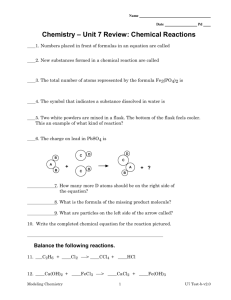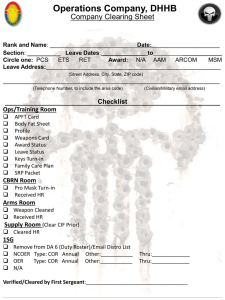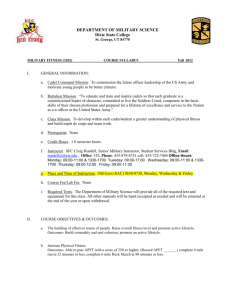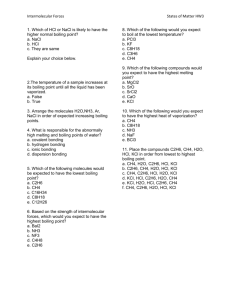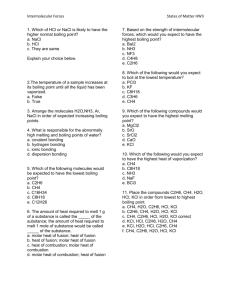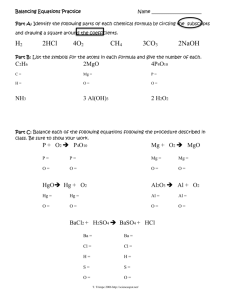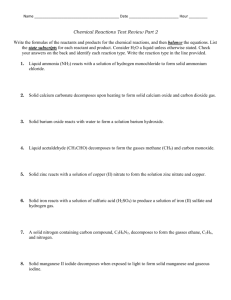APFT Week of Prep Guide
advertisement
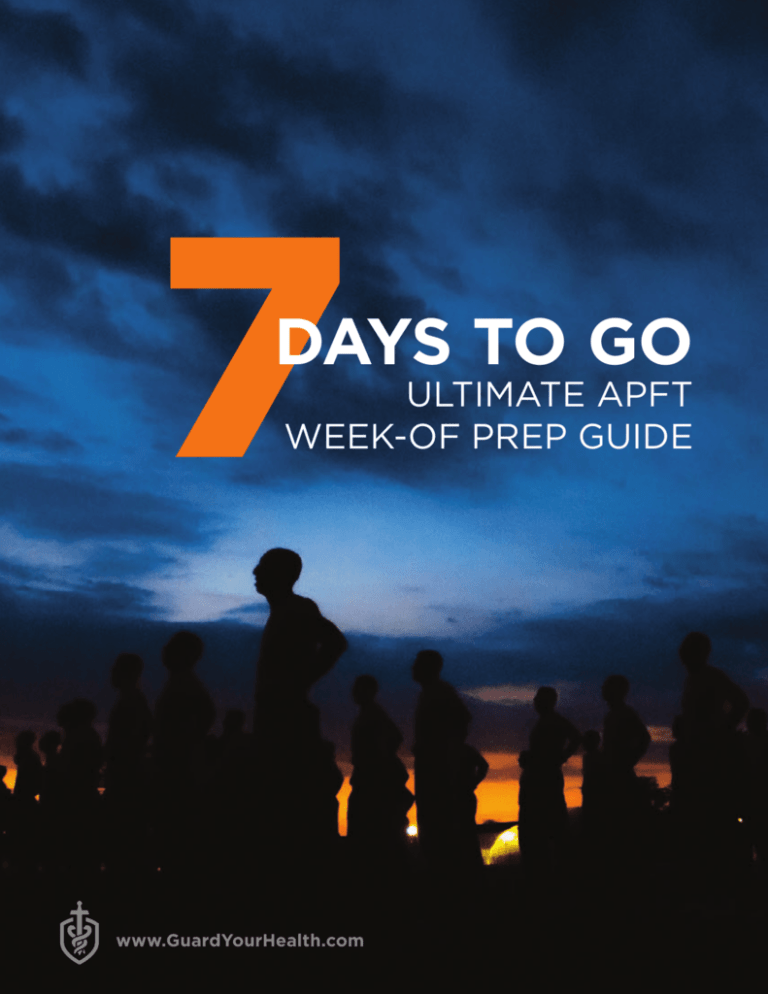
7 DAYS TO GO ULTIMATE APFT WEEK‑OF PREP GUIDE www.GuardYourHealth.com CONTENTS Part 1: The Week of Your Test . . . . . . . . . . . . . . . . . . . . . 1 Part 2: The Day/Night Before Your Test . . . . . . . . . . . .4 Part 3: Test Day . . . . . . . . . . . . . . . . . . . . . . . . . . . . . . . . . 7 Part 4: Life AFTER the APFT. . . . . . . . . . . . . . . . . . . . . 12 DISCLAIMER: Preparation for the APFT can be strenuous. You should consult a trained medical professional before you begin any strenuous exercise program, before making any changes in your diet and/or physical activity levels, and before adopting any of the information contained in this or other guides. This is especially true if you have or suspect that you may have heart disease, high blood pressure, diabetes, or any other medical conditions. If you feel faint or dizzy at any time while performing PT training, stop immediately and seek medical evaluation. The United States Government and any service member, civilian, or contractor employed by the United States Government disclaims any liability, personal or professional, resulting from the misapplication of any training procedure, technique, or guidance described in this guide. This guide is informational purposes only, and does not constitute medical advice or guidance. It is also not meant to replace guidance provided by your physician or a trained medical professional or fitness instructor. Download Guide: http://www.guardyourhealth.com/toolkits/soldier‑guides/ | i Part 1: The Week of Your Test The decisions you make in the final days leading up to your APFT can significantly influence your test performance and score. Fast Facts Week of Your Test Within four days of the test, start to scale back, `` or taper, your training. Take it easy, incorporate more rest, and do not push your body to the point of muscle failure. Heavy workouts within three days of your APFT `` could reduce your overall score by up to 15 points. What you eat and drink in the three days leading `` up to your APFT will be used as fuel on test day. Make sure to start hydrating and eat a balanced diet rich in complex carbohydrates in the days leading up to your APFT. Aim for at least seven to eight hours of sleep `` each night. Download Guide: http://www.guardyourhealth.com/toolkits/soldier‑guides/ | 2 Week of APFT Training Guide 7 Days to Go Pre-test day. Get a friend to help you record your practice test results. First, see how many pushups you can do until muscle failure within two minutes. Take a break for 10-15 minutes and then repeat for sit-ups. Take another break for 10-15 minutes before running two miles. Put your numbers into the APFT calculator at http://j.mp/ APFTcalc to see what your score would be if it was test day today! 6 Days to Go Six days out from your APFT, you should take a day off from your usual exercise routine. Mentally prepare for the week ahead by practicing deep breathing exercises when you wake up and before you go to sleep: for two minutes, breathe in for three seconds and out for three seconds. Try this 5-minute meditation guide: http://j.mp/howtomeditate5. 5 Days to Go With only five days to go, you don’t want to do anything that might compromise your test-day performance. Make your workout today slightly easier than your usual exercise routine and avoid pushing yourself to muscle failure. 4 Days to Go Start to scale back your workout. Do modified versions of the activities you will do for the APFT without exerting maximum effort. Run two miles at a slightly slower pace than your target APFT speed. For example, if you are shooting for a 15:00 two-mile pace during your test, shoot for a 16:30 or 17:00 two-mile run to go about a minute slower per mile. Consider doing push-ups on your knees and crunches instead of sit-ups. Set your timer for only 3060 seconds instead of the full two minutes. 3 Days to Go No working out. Seriously. Take it easy today and give your body a chance to relax and recover. Practice some dynamic stretching to keep your muscles and joints loose and ready, but that’s it! 2 Days to Go Do a modified workout. Go for a light, one- to two-mile run and make sure you stretch before and after: http://j.mp/APFTstretch. Perform modified push-ups and crunches at your goal pace for 30-60 seconds. you’re having a hard time getting enough sleep, try out these tips to ease anxiety and get to sleep faster: http://j.mp/APFTsleep. Download Guide: http://www.guardyourhealth.com/toolkits/soldier‑guides/ | 3 Part 2: The Day/Night Before Your Test You are so close. All your hard work and preparation is about to pay off. You are well positioned to dominate this APFT, as long as you make smart choices today and on test day. Fast Facts The Day/Night Before Your Test `` Remember, fasting is never recommended as a method for shedding pounds. However, if you have been fasting, you absolutely need to stop and resume regular meals and water intake within 24 hours of the test. Otherwise, you put your health (and you APFT performance) at risk! Don’t rock the boat – now is not the time to `` try out a new running shoe or get creative in the kitchen. Stick with what worked during training. No working out the day before the test. Rest, `` hydrate, and eat well. Download Guide: http://www.guardyourhealth.com/toolkits/soldier‑guides/ | 5 How to Eat, Sleep, & Prepare The Day/Night Before the APFT Use the HERS strategy to guide your activities on the day/night before the test. Hydrate ` Check out our hydration calculator (http://j.mp/hyrdationcalc) to determine how much water you should be drinking daily. ` Drink one to two cups (eight to 12 ounces) of water every other hour to ensure you are well hydrated for test day. Aim for between 10 and 14 cups (80 to 112 ounces) total. Eat Smart ` Eat dinner at least two to three hours before bed to avoid sleep disruptions. ` Eat a bland and balanced meal; incorporate both lean proteins, like chicken or fish, and complex carbohydrates, like whole wheat pasta or bread, to protect and repair your muscles and keep your blood sugar levels from crashing. ` Use this guide for APFT-friendly dinner ideas: http://j.mp/APFTMealTiming. Rest and Prep ` DON’T work out the day before test day. ` Go for a leisurely walk and visualize finishing the APFT successfully. ` Use the extra time to get yourself ready and focused for the test. ` Lay out your clothes and pack the night before. Be sure to bring extra water bottles, a sweat towel, and APFT-friendly snacks to use as fuel for before, during, and after the test. Sleep ` Aim for eight hours of sleep the night before your APFT. Trouble falling asleep? Check out these tips: http://j.mp/GXsleep. ` Get in bed 45-60 minutes before your target sleep time to allow yourself enough time to unwind. ` Set two alarms. If your test is in the morning, wake up three to four hours before your test so you have plenty of time to wake up, eat a light meal, and arrive to the test site early. Download Guide: http://www.guardyourhealth.com/toolkits/soldier‑guides/ | 6 Part 3: Test Day You’ve trained. You’ve sweated. And now it’s time for you to show the APFT who’s boss. Proceed with confidence into the test and use these techniques to give yourself a final bump. Fast Facts Test Day Eat a light, easily digestible meal two to three `` hours before the first test event. Although each individual is different, a good rule of thumb is to aim for 30 to 50 grams of good carbs and 10-15 grams of lean protein. You should experiment during training to find out the ideal mix for your body in order to optimize your performance. If needed AND tolerated, eat a small snack `` one to two hours before the test. More on what to eat and when to eat it: http://j.mp/APFTMealTiming. Drink two to three cups (16 to 24 ounces) of `` water two to three hours before your APFT; drink another cup (8 ounces) 10-15 minutes before it begins. Be sure to warm up with dynamic stretches `` (no static stretching) before every event. Learn more: http://j.mp/APFTstretch. Download Guide: http://www.guardyourhealth.com/toolkits/soldier‑guides/ | 8 The Morning of the APFT Rise and stretch: Set your alarm for two to three hours before your test, if possible, so you have plenty of time to get ready, eat breakfast, and fully wake up. Before you get out of bed, stretch out your arms and legs until fully straight, then put your hands behind your head, rotate your hips so your right hip is down and left is up, and bring your knees up to your chest. Repeat on the opposite hip. Hydrate: Perfect 300 Tip Drink 2-3 cups of water about two to three hours before the apft. Drink one more cup 10-15 minutes before it begins. To prevent crashing before the APFT is over, avoid energy drinks and sugary food the morning of your test. Instead, drink two to three cups (16 to 24 ounces) of water when you wake up, or about two to three hours before the test. Then, drink one more cup (8 ounces) of water about 30-60 minutes before the test. Eat smart: In terms of breakfast foods, don’t go overboard. Eat a light (emphasis on the light!), balanced, and easily digestible meal about two to three hours before the test to avoid feeling too full and sluggish. Choose healthy proteins and carbohydrates like eggs, yogurt, nuts, fruit, smoothies, cereal, and whole wheat toast. An example breakfast might include a hard-boiled egg and a piece of toast with fruit jelly. Avoid eating fibrous veggies (e.g., broccoli, onions, and beans) that could cause gas as well as highfat foods that are hard to digest. Snack smart: If you are used to eating often and can tolerate it, you may also want to bring a light snack to the test site to eat within 60 minutes of the first test. Half of a PB&J, or a half of a banana plus a handful of raisins and nuts, will provide long-lasting energy without giving you gas or cramps. Perfect 300 Tip Sugary snacks and drinks will make you crash. If you need a snack before the test, have an apple, banana, nuts, or half of a pb&j. Download Guide: http://www.guardyourhealth.com/toolkits/soldier‑guides/ | 9 Prior to Each Event Depending on your test administrator and the number of Soldiers taking the APFT with you, you will have a 10- to 20-minute break between events. Be sure to drink small amounts of water – slowly – in between events. Also, use these warm-ups to safely prepare the right muscle groups before each event: Before the 2‑minute push‑up event: Perfect 300 Tip During breaks, drink small amounts of water slowly to replenish fluids lost during sweating. Five minutes before the push-up event begins, do five to 10 pushups at a medium to slow pace. Before 2‑minute sit‑up event: During the break between push-ups and sit-ups, knock out two to three unassisted sit-ups as a performance-enhancing warm up. Before the 2‑mile run: After the sit-ups and before the run, jog in place or do walking lunges for about a minute to warm up for running. During the Test There are small adjustments you can make during the test, especially in your form and technique, to boost your score. For instance: During 2‑minute push‑up event: Perfect 300 Tip Breathing in and out at the right time is key. For push-ups and sit-ups, follow the “exhale on exertion” rule of thumb. Pause to rest when you are about halfway to your typical max. Take two quick breaths, and then knock out five more reps. Repeat until time is up. For example, if you usually do 50 pushups in two minutes, you will want to: crank out 25, pause, take two quick breaths, get to 30, take two more breaths, get to 35, and so on. In other words, don’t wait until you have reached your limit to rest – you need to proactively rest. During 2‑minute sit‑up event: To make sure you get enough air, inhale when you lay back and exhale when you sit up. For maximum reps, adjust your form slightly, to the extent your test administrator will allow, to make it easier: place your feet just slightly further from your butt than you did during training without breaking form regulations. During the 2‑mile run: Use rhythmic breathing techniques for pacing and to ensure you’re getting enough oxygen. Try taking a breath every other time your left foot hits the ground while exhaling on every other right step. This is known as the 3:2 ratio http://j.mp/breatheAPFT. Download Guide: http://www.guardyourhealth.com/toolkits/soldier‑guides/ | 10 Immediately After the Test You did it! Congrats! Follow these steps to recover and reduce the risk of injury. Cool down from the run by lightly jogging in place for one minute, walking for 10 minutes, and then laying down and doing scissor kicks, or doing slowpaced jumping jacks. Immediately after cool down, stretch every muscle group you worked. Check out this list of safe, fullbody stretches: http://j.mp/APFTstretch. Replenish fluids by drinking enough water to quench thirst initially. Then, drink another eight ounces within an hour after cool down. If you’re feeling wiped out, eat an apple or banana or drink fruit juice for instant energy. A glass of milk or a piece of bread with nut butter is also great for recovery. Download Guide: http://www.guardyourhealth.com/toolkits/soldier‑guides/ | 11 Part 4: Life AFTER the APFT The APFT isn’t the end, it’s just the beginning. Want to make training for next year’s APFT easier? Commit to maintaining your healthy habits and fitness year round. Not only will it make your next APFT easier, it will also help you look, feel, and perform at your best. Day After the Test Give your muscles a break the day after the test. If you feel like you overdid it, follow the RICE rule: rest, ice, compression, and elevation. Perfect 300 Tip Did you push it too hard? Follow RICE rule: Rest Ice Compression Elavation If you experience soreness the next day, go for a short, brisk walk or light run, just to get moving. When you move around, your heart pumps fresh blood to sore muscle groups, providing oxygen and other elements necessary for recovery. This can help speed up the recovery process. Some soreness during recovery is normal, but if you are experiencing discomfort days after the APFT, it could be something more serious, and you should consider seeing a trained medical professional. Follow these guidelines: http://j.mp/SportInjuries. Rest of the Year After a day of rest, you can begin to ease back into a normal workout routine. You will want to keep up your cardio level and muscular strength and eat properly to maintain your fitness so you are mission ready 365 days a year (bonus: APFT preparation will be a lot easier!) Keep these tips in mind throughout the year: • Align your “maintenance” routine to your long-term fitness goals. If you don’t have any specific fitness goals, define them. You can use the APFT as a starting point. For instance, what APFT score do you want to aim for next time, and what do you need to get there? Make your goals straight forward and set a day you want to achieve it by. • Your workout routine should vary based on your current fitness level and other considerations (e.g., injuries, physical limitations, and schedule). • Healthy eating is a critical element of fitness. Check out Guard Your Health’s nutrition resources (http://j.mp/GYHnutrition). Also, print out this fridge-worthy infographic “Hand Guide to Portion Control” to make sure you aren’t overeating (http://j. mp/GYHhandguide). • Do a practice APFT once a month and track your scores using the APFT Calculator (http://j.mp/APFTcalculator). Use the results to identify areas where you can improve. Download Guide: http://www.guardyourhealth.com/toolkits/soldier‑guides/ | 13 Helpful Resources Follow Guard Your Health on social media for inspiration, sample meals, and fitness tips. Find Guard Your Health on Facebook (https://www.facebook.com/ARNGHealth) and Twitter (https:// twitter.com/ARNGHealth). Also, you can use the following resources and tools to help establish a fitness plan that works for you: ` Guard Your Health Fitness Resources (the go-to place for all things fitness for Guard Soldiers): http://j.mp/GYHfitness. ` Performance TRIAD App (A comprehensive guide to eat, sleep, and exercise smarter): http://j.mp/performanceTRIAD. ` Army Physical Readiness Training App (Mobile app containing sample training schedules with drill and exercise demos, timers, and body composition calculators): http://j.mp/ARMYPRT. ` U.S. Army Pocket Physical Training Guide (A comprehensive PT resource containing sample PT workouts galore): http://j.mp/ ARMYpocketguide. ` Guard Your Health APFT Calculator (A mobile-friendly tool that enables you to input your practice test scores to calculate your overall score): http://j.mp/APFTcalculator. WEBLINK DISCLAIMER: The appearance of hyperlinks to external sites does not constitute endorsement by the Department of the U.S. Army of the linked website or the information, products, or services contained therein. For other than authorized activities such as military exchanges and Morale, Welfare, and Recreation sites, the Department of the U.S. Army does not exercise any editorial control over the information you may find at these locations. Such links are provided consistent with the stated purpose of this DoD website. Download Guide: http://www.guardyourhealth.com/toolkits/soldier‑guides/ | 14

